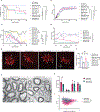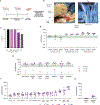Intra-amniotic antisense oligonucleotide treatment improves phenotypes in preclinical models of spinal muscular atrophy
- PMID: 40367190
- PMCID: PMC12423764
- DOI: 10.1126/scitranslmed.adv4656
Intra-amniotic antisense oligonucleotide treatment improves phenotypes in preclinical models of spinal muscular atrophy
Abstract
Neurological disorders with onset before or at birth are a leading cause of morbidity and mortality in infants and children. Prenatal treatment has the potential to reduce or prevent irreversible neuronal loss and facilitate normal neurodevelopment. We hypothesized that antisense oligonucleotides (ASOs) delivered to the amniotic fluid by intra-amniotic (IA) injection could safely distribute to the fetal central nervous system (CNS) and provide therapeutic benefit in the motor neuron disease spinal muscular atrophy (SMA), caused by mutations of the survival of motor neuron 1 gene (SMN1), leading to deficiency of SMN protein. Although the splice-switching ASO nusinersen ameliorates SMA when delivered postnatally, substantial deficits can remain in severely affected infants. Here, IA injection of ASOs into two mouse models of severe SMA increased SMN expression in the CNS. In SMAΔ7 mice, which manifest pathology in utero, prenatal treatment improved motor neuron numbers, motor axon development, motor behavioral tests, and survival when compared with those in mice treated postnatally (between P1 and P3). To assess the feasibility of prenatal treatment in a large-animal model, ASOs were delivered midgestation to fetal sheep by IA or intracranial injection. ASOs delivered by IA injection distributed to the spinal cord at therapeutic concentrations and to multiple peripheral tissues without evidence of substantial toxicity to the fetus or mother. These data demonstrated that IA delivery of ASOs holds potential as a minimally invasive approach for prenatal treatment of SMA and possibly other severe, early-onset neurological disorders.
Conflict of interest statement
Figures






References
-
- Lopez-Rivera JA, Perez-Palma E, Symonds J, Lindy AS, McKnight DA, Leu C, Zuberi S, Brunklaus A, Moller RS, Lal D, A catalogue of new incidence estimates of monogenic neurodevelopmental disorders caused by de novo variants. Brain 143, 1099–1105 (2020); published online EpubApr 1 ( 10.1093/brain/awaa051). - DOI - PMC - PubMed
-
- Herzeg A, Almeida-Porada G, Charo RA, David AL, Gonzalez-Velez J, Gupta N, Lapteva L, Lianoglou B, Peranteau W, Porada C, Sanders SJ, Sparks TN, Stitelman DH, Struble E, Sumner CJ, MacKenzie TC, Prenatal Somatic Cell Gene Therapies: Charting a Path Toward Clinical Applications (Proceedings of the CERSI-FDA Meeting). J Clin Pharmacol 62 Suppl 1, S36–S52 (2022); published online EpubSep ( 10.1002/jcph.2127). - DOI - PMC - PubMed
MeSH terms
Substances
Grants and funding
LinkOut - more resources
Full Text Sources

